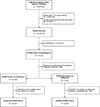Association of inpatient vs outpatient onset of ST-elevation myocardial infarction with treatment and clinical outcomes
- PMID: 25399275
- PMCID: PMC4266685
- DOI: 10.1001/jama.2014.15236
Association of inpatient vs outpatient onset of ST-elevation myocardial infarction with treatment and clinical outcomes
Erratum in
-
Revisions in table.JAMA. 2015 May 5;313(17):1758. doi: 10.1001/jama.2015.3923. JAMA. 2015. PMID: 25942739 No abstract available.
Abstract
Importance: Reperfusion times for ST-elevation myocardial infarction (STEMI) occurring in outpatients have improved significantly, but quality improvement efforts have largely ignored STEMI occurring in hospitalized patients (inpatient-onset STEMI).
Objective: To define the incidence and variables associated with treatment and outcomes of patients who develop STEMI during hospitalization for conditions other than acute coronary syndromes (ACS).
Design, setting, and participants: Retrospective observational analysis of STEMIs occurring between 2008 and 2011 as identified in the California State Inpatient Database.
Exposures: STEMIs were classified as inpatient onset or outpatient onset based on present-on-admission codes. Patients who had a STEMI after being hospitalized for ACS were excluded from the analysis.
Main outcomes and measures: Regression models were used to evaluate associations among location of onset of STEMI, resource utilization, and outcomes. Adjustments were made for patient age, sex, comorbidities, and hospital characteristics. The analysis allowed for the location of inpatient STEMI to have a multiplicative rather than an additive effect for resource utilization since these measures were highly skewed.
Results: A total of 62,021 STEMIs were identified in 303 hospitals, of which 3068 (4.9%) occurred in patients hospitalized for non-ACS indications. Patients with inpatient-onset STEMI were older (mean, 71.5 [SD, 13.5] years vs 64.9 [SD, 14.1] years; P < .001) and more frequently female (47.4% vs 32%; P < .001) than those with outpatient-onset STEMI. Patients with inpatient-onset STEMI had higher in-hospital mortality (33.6% vs 9.2%; adjusted odds ratio (AOR), 3.05; 95% CI, 2.76-3.38; P < .001), were less likely to be discharged home (33.7% vs 69.4%; AOR, 0.38; 95% CI, 0.34-0.42; P < .001), and were less likely to undergo cardiac catheterization (33.8% vs 77.8%; AOR, 0.19; 95% CI, 0.16-0.21; P < .001) or percutaneous coronary intervention (21.6% vs 65%; AOR, 0.23; 95% CI, 0.21-0.26; P < .001). Length of stay and inpatient charges were higher for inpatient-onset STEMI (mean length of stay, 13.4 days [95% CI, 12.8-14.0 days] vs 4.7 days [95% CI, 4.6-4.8 days]; adjusted multiplicative effect, 2.51; 95% CI, 2.35-2.69; P < .001; mean inpatient charges, $245,000 [95% CI, $235,300-$254,800] vs $129,000 [95% CI, $127,900-$130,100]; adjusted multiplicative effect, 2.09; 95% CI, 1.93-2.28; P < .001).
Conclusions and relevance: Patients who had a STEMI while hospitalized for a non-ACS condition, compared with those with onset of STEMI as an outpatient, were less likely to undergo invasive testing or intervention and had a higher in-hospital mortality rate.
Figures
References
-
- Jollis JG, Roettig ML, Aluko AO, et al. Implementation of a statewide system for coronary reperfusion for ST-segment elevation myocardial infarction. JAMA. 2007 Nov 28;298(20):2371–2380. - PubMed
-
- Krumholz HM, Bradley EH, Nallamothu BK, et al. A campaign to improve the timeliness of primary percutaneous coronary intervention: Door-to-Balloon: An Alliance for Quality. JACC Cardiovasc Interv. 2008 Feb;1(1):97–104. - PubMed
-
- Jacobs AK, Antman EM, Faxon DP, Gregory T, Solis P. Development of systems of care for ST-elevation myocardial infarction patients: executive summary. Circulation. 2007 Jul 10;116(2):217–230. - PubMed
-
- Peterson ED, Roe MT, Rumsfeld JS, et al. A call to ACTION (acute coronary treatment and intervention outcomes network): a national effort to promote timely clinical feedback and support continuous quality improvement for acute myocardial infarction. Circulation. Cardiovascular quality and outcomes. 2009 Sep;2(5):491–499. - PubMed
Publication types
MeSH terms
Grants and funding
LinkOut - more resources
Full Text Sources
Other Literature Sources
Medical


